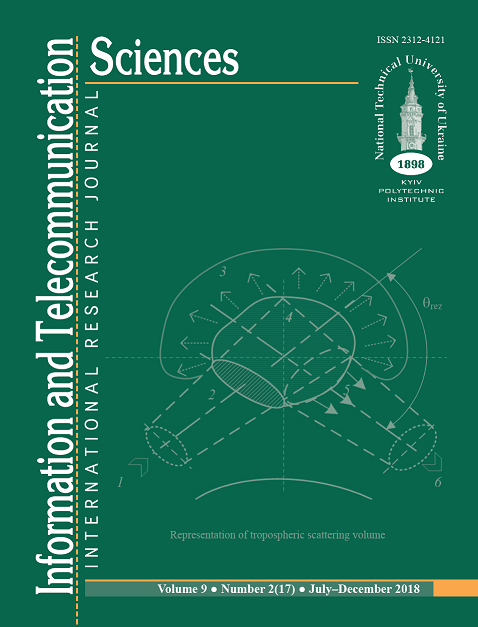SELECTION AND RECOGNITION OF THE SPECIFIED RADIO SIGNALS IN THE SW BAND
DOI:
https://doi.org/10.20535/2411-2976.22018.21-26Keywords:
radio monitoring, frequency resource, algorithms for selection and recognition of specified radio signals, unknown radio signals.Abstract
Background. Currently, the wireless radio technologies are an intensively developing branch of the telecommunications industry, due to their high popularity as a result of their convenience for civilian and specialized applications. Currently, the frequency resources are already quite overloaded, which leads to electromagnetic compatibility problems. This problem can be
solved by efficient use of the frequency resource; for this purpose, monitoring of the radio frequency resource use by means of automated radio monitoring is carried out. Now a lot of radio-electronic means are operating at the moment and their number is rapidly increasing every day, which can lead to the fact that not only radio signals can be received, but also unknown signals,
which in turn can lead to recognition errors. The paper studies the algorithms of selection and recognition of given radio signals, which take into account the class of unknown signals.
Objective. The aim of the paper is to research the quality indicators of the selection and recognition algorithms for given radio signals in the presence of unknown signals during radio monitoring in the SW band.
Methods. Investigation of algorithms for selection and recognition of specified radio signals in the presence of unknown signals by the simulation method on real signal samples.
Results. The values of quality indicators of selection and recognition of specified radio signals in the presence of unknown signals that are acceptable for the practice of radio monitoring are obtained. The proposed recognition algorithms should improve the quality of radio monitoring results, and thereby improve the
results of radio monitoring.
Conclusions. The proposed algorithms for the selection and recognition of specified radio signals in the presence of
unknown signals will improve the quality of radio monitoring in the SW band.
References
Kokhanovich G.F., Babak V.P., Fisenko V.M.
Special radio monitoring. - Kiev: MK-Press, 2007. -
p.
Rembovsky, AM, Ashihmin AV, Kozmin VA ..
Radiomonitoring: objectives, methods, tools. - M.:
Hotline-Telecom, 2012. - 641 p.
Kim K. Cyclostationary approaches to signal
detection and classification in cognitive radio //New
frontiers in dynamic spectrum access networks. 2nd
IEEE international symposium. – IEEE, 2007. - С.
-215.
Duda R.O., Hart P.E., Stork D.G. Pattern
classification 2nd Edition. - Wiley-Interscienceю, 2001.
- 738 P.
Weber, C. Automatic modulation classification
technique for radio monitoring/ C. Weber, M. Peter, T.
Felhauer // Electronics Letters. – 2015. – Vol. 51, №
– P. 794-796.
Anderson T. Statistical analysis of time series. -
M .: Mir, 1976. - 755 p.
Ayvazyan S.A., Bezhaeva Z.I., Staroverov O.L.
Classification of multidimensional observations. - M .:
Statistics, 1974. - 239 p.
Theory of signal detection / Ed. P.A. Bakuta. -
M .: Radio and communication, 1984. -440 p.
Senin A.G. Recognition of random signals. -
Novosibirsk: Science, 1974. - 76 p.
Libenson M.N. Nonlinear statistical method for
recognizing many classes // Problems of random search.
- Riga: IC of the Academy of Sciences of Latvia, 1978.
- Vol. 6. - P.299-317.
Omelchenko V.A. Basics of the spectral theory
of signal recognition. - Kharkov: High school, 1983. -
p.
Omelchenko V.A. Recognition of random
signals in conditions of a priori uncertainty. - Kharkov:
KhPI, 1979. -100 p.
. Fefelov N.A. Pattern recognition in the
presence of a new class // Selection and processing of
information. - 1988. - Vol. 2. - P.84-89.
Bezruk V.M., Pevtsov G.V. Theoretical
foundations of the design of signal recognition systems
for automated monitoring. - Kharkov: Collegium, 2007.
- 430 p.Jondral F. K. Software-defined radio: basics and
evolution to cognitive radio //EURASIP journal on
wireless communications and networking. – 2005. – Т.
, №. 3. – P. 275-283.
Downloads
Published
How to Cite
Issue
Section
License
The ownership of copyright remains with the Authors.
Authors may use their own material in other publications provided that the Journal is acknowledged as the original place of publication and National Technical University of Ukraine “Igor Sikorsky Kyiv Polytechnic Institute” as the Publisher.
ITS articles are published under Creative Commons licence:
- Authors retain copyright and grant the journal right of first publication with the work simultaneously licensed under CC BY 4.0that allows others to share the work with an acknowledgement of the work's authorship and initial publication in this journal.
- Authors are able to enter into separate, additional contractual arrangements for the non-exclusive distribution of the journal's published version of the work (e.g., post it to an institutional repository or publish it in a book), with an acknowledgement of its initial publication in this journal.
- Authors are permitted and encouraged to post their work online (e.g., in institutional repositories or on their website) prior to and during the submission process, as it can lead to productive exchanges, as well as earlier and greater citation of published work.

